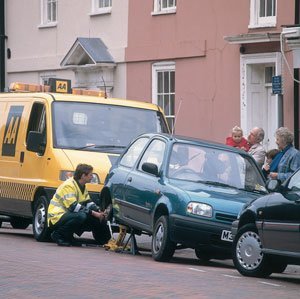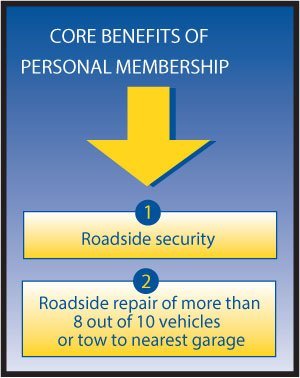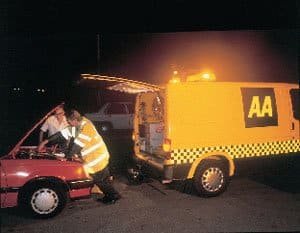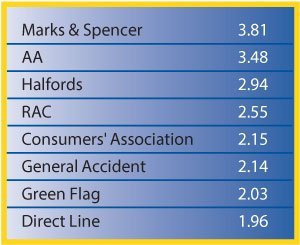
Customer service can be used to achieve a personal relationship by focusing on meeting needs and requirements. The term can be used to describe the personal relationship that develops between the customer and the company. This relationship will only be achieved by taking the time and effort to research the customers to find out exactly what their requirements are and then satisfy those requirements.
This case study features the Automobile Association (AA) and shows how, by paying close attention to the service it offers through personal membership, it has been able to consolidate and enhance its position as the UK’s largest motoring organisation using the skills of the world’s largest patrol force. In particular, the case focuses on the ways in which the AA has created a close personal relationship with its customers, in order to provide services that truly reflect their needs.
“Trust” is a very important part of the relationship the AA has with its members. Stranded motorists are particularly vulnerable and want to know they are being cared for and looked after by an organisation which has their interests at heart. In some ways, the relationship is similar to that between a doctor and a patient. Motorists want to know that they are in safe hands and that they are being well looked after. The case study reflects this very special relationship; one which will be particularly appreciated by anyone whose family or friends have had a car breakdown at a particularly awkward time.
The AA
The AA was founded in 1905 to protect the interest of pioneer motorists and remains a non-profit making mutual benefit organisation, offering a range of products and services. It is a huge business group with 9 million members, more than 12,000 staff and 40 different business activities. AA patrols attend 4.9 million breakdowns per year and the organisation takes and receives 35 million telephone calls each year. There are two main categories of members – personal and business members.
- The 3 million business members are made up of both employees of organisations that take out AA membership for their fleets of vehicles and motor vehicle manufacturers, such as Vauxhall, which includes the benefit of free AA membership to customers buying new cars.
- The remaining 6 million consists of 4.3 million personal members and a further 1.7 million family and related members. The personal members are, in effect, the individuals who have initiated the application for membership. The organisation is currently divided into four major business groups:
- AA Membership and Call Handling
- AA Insurance, Financial Services and Retail (including direct sales)
- AA Commercial Services (including the driving school, publishing and maps, hotel approval scheme, in-car technology and multi-media)
- Cross-business support activities (including a range of important activities such as market research, public relations, print and information technology).
“Courtesy and care” have been the hallmarks of the service given over the years and the AA continues with a commitment to the time-honoured values that have stood it in such good stead.
This case study focuses on the AA’s core business activity, namely providing a personal service to members at the roadside. It shows how the AA has built a range of value-added benefits to this core service, which has supported and enhanced its reputation and quality image.
Modern organisations develop mission statements which are designed to provide a clarification of purpose, in order to generate commitment throughout the business. The group mission statement of the AA is encapsulated in the following consumer statement:
“I instinctively turn to the AA – you are always there, easy to reach and ready to help. You have standards I can trust and you impress me more every time you serve me and solve my problems.”
When every one of its members and customers can say this, the AA believes it will be irresistible. Customers buy goods and services from one organisation rather than another because the “winning organisation” provides better value for money by providing the “benefits” that consumers want at an attractive price.
The key to success is to provide these benefits in a competitive way. The usual route to a competitive edge is through adding more value to your product than your competitor. In other words, to be highly successful, a business has to demonstrate to customers that the values it delivers are significantly more appealing than those offered by alternative organisations.
In business there is a saying that you don’t sell goods and services – you sell benefits. The reason for the success of the AA and other organisations like Marks & Spencer, British Steel, Kodak and IBM is that they have clearly demonstrated the provision of “excellent benefits” in their relevant markets.

However, if a car cannot be repaired at the roadside, it will normally be towed, free of charge, to the nearest AA appointed garage or to the motorist’s home. Other key benefits of AA membership include:
- The AA Magazine, which is distributed four times per year, incorporates features on issues affecting motorists, consumer advice, road tests, special offers exclusive to members and, of course, news about AA products and services.
- A members’ benefit book at policy renewal.
- The Members’ Handbook is currently mailed to all personal members every two years. The Handbook is essential for all motorists and contains maps of the United Kingdom, details of AA services, a directory of AA shops and appointed hotels and star ratings, details of breakdown procedures and other essential information.
- Discounts for members in AA shops, insurance policies and other financial services.
- A service setting out the best routes for journeys in the UK.
- Technical and legal advice and information.

First stage change – an IT revolution
In the UK, the development of information technology has often been the driving force for organisational change. Information technology makes it possible to handle vast quantities of information at the touch of a button or computer key. For the AA, this provided an important step forward. With the rising number of motorists in the UK, it was essential to devise quick and easy to operate systems which would take much of the pressure away from more traditional systems. A network of interconnected telephone and computer systems made it possible to respond quickly to urgent customer needs – e.g. in the case of roadside breakdowns.
Second stage change – doing the market research
In 1989, it was recognised that competitors were being successful in closing the market share gap by developing excellent customer care. Market research is the key for market focused organisations and gives them the opportunity to discover what customers want and need.
Therefore, in order to understand what members wanted from the AA, a massive and detailed research programme was undertaken. Members were asked:
“What do you want?”
“What are your needs?”
The results of the research were conclusive and provided the AA with a clear agenda for continuous improvement. The benefits required were:
- The organisation radiates a “caring attitude”.
- Be given advice as to what they should do when waiting for a patrol.
- The car is to be repaired at the roadside, or, if the vehicle has to be taken to a garage, it should be to an AA recommended outlet.
- The AA to warrant the validity of the work carried out.
The survey re-affirmed that the main benefits customers required were:
- Repairing the vehicle;
- Speed of arrival from the initial call.
Following this market research, a customer satisfaction index was established that tells the AA, on a monthly basis, how members feel about the service received. This is compared with the actual service standards recorded by the AA for every breakdown, to create the index. One in every 34 members who break down receives a questionnaire a short time after the incident. Since the index began, more than 200,000 members have responded.
In common with other major UK companies in the mid 1990s, the AA has set out to create a more responsive organisation, cutting out waste and bureaucracy. This has involved removing layers of surplus management – a process known as “delayering”.
In modern business organisations, the emphasis has increasingly been on empowering front-line employees – i.e. those who deal directly with customers. Employees are encouraged to take the initiative, solve problems themselves and be confident in their dealings with customers. Of course, this has involved extensive training programmes to ensure that staff have the competencies and skills required to deliver quality services.
Until very recently, 80% of staff costs at the AA were in the front line, with a substantial 20% of costs covering management. In order to reduce overhead costs to give members better value for money the AA has been involved in a major delayering programme. As a result, management levels have been reduced from 12 to three levels since 1988. As with all restructuring programmes, this has placed enormous strain on the organisation in seeking to maintain morale.
The way forward has dictated that employees understand the need for change so that they can identify their part in improving customer service excellence. In a highly competitive field, if the AA failed to deliver superior benefits, competitors would certainly do so. To this end, the AA has engaged in a major reconstruction programme, involving re-training its employees. It has flattened its organisational structure and introduced team working and team briefings. In addition, new IT programmes have been initiated to improve customer service further. In particular, the focus today is on enabling all AA employees to serve customers effectively.

The net effect of the AA’s emphasis on building personal relationships with customers has been that members genuinely feel that the AA shows a concern for their requirements. The AA is therefore associated in customers’ minds with quality and this is why members are prepared to buy related products and services from the AA in addition to standard membership.

The proof of the AA’s success is measured in terms of the size of its membership and through the perceptions of the service it offers. On both counts, it has been remarkably successful. In terms of public perceptions of its performance, recent research from the research company, The Research Business, clearly confirms that AA has a very high saliency or identification with its customers.
